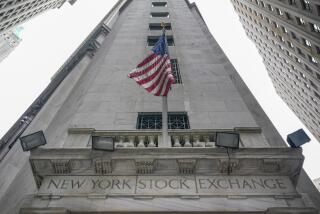The dollar’s international dominance is a problem. Here’s why

- Share via
Current and former central bankers in Jackson Hole, Wyo., weren’t sure if Mark Carney’s idea for a virtual reserve currency is the answer, but they agree that the dollar’s dominance is a problem.
The Bank of England governor used the Kansas City Federal Reserve’s annual symposium to set out a radical goal: Invent a currency that is similar to Facebook Inc.’s proposed Libra, is based on several widely used ones and would eventually replace the dollar’s role in international transactions.
Carney’s provocative pitch this weekend highlighted the simultaneous struggle 5,000 miles away of Group of 7 leaders in France, who were trying to preserve some semblance of the international order amid President Trump’s regular Twitter outbursts. Monetary policymakers at the foot of Wyoming’s Teton mountains spent Friday and Saturday debating how they can strengthen the world economy, with increasing doubts about how much more they can do.
Adam Posen, a former Bank of England policymaker, argued that there are still fundamental political and economic reasons why people rely on the dollar — mainly that it wins a “least ugly” contest against, say, the euro or China’s yuan. While it’s possible to have multiple reserve currencies, countries have tried using synthetic basket currencies before and that hasn’t really worked, he said.
“The desire to get out from total dominance of the U.S. currency is probably healthy,” said Posen, who is now president of the Peterson Institute for International Economics in Washington. Even so, “the idea that there’s a technological fix that will achieve it strikes me as mistaken.”
Smaller countries suffer
Having the dollar as the dominant reserve currency works reasonably well as long as the United States and the rest of the world are more or less in sync. But now that the United States’ economy is doing better than most, pushing the dollar higher, smaller countries are suffering more than they should. Trump’s tariffs on imports from China and elsewhere are adding to the dollar’s strength as well, making matters even worse.
Additionally, emerging-market countries increasingly pay for imports in dollars, which means they can no longer rely on moves in their own currencies to absorb shocks.
Stanford University economists Arvind Krishnamurthy and Hanno Lustig presented a paper at Jackson Hole saying the dollar had become like gold. They said increased demand for Treasuries, as well as tighter U.S. monetary policy, causes the dollar to appreciate.
Libra-like suggestion
“Mark [Carney] shone a light on something that’s important,” Krishnamurthy said in an interview. “From my work in studying the role of the dollar in the international monetary system, it does strike me that he’s right,” yet “I don’t think the central banking community has really taken it into account.”
Carney suggested there may be a solution in new technology that hasn’t been tested. Facebook Inc.’s Libra is planned to be a worldwide digital currency that could lie outside the direct control of central banks, but so far most policymakers have been skeptical. Carney, who leaves the Bank of England next year, said the new currency he has in mind would be controlled by public authorities.
“It was a remarkable speech,” said Olli Rehn, who sits on the European Central Bank’s Governing Council. “It’s an idea worth pondering in a wider context of the digitization of our monetary and banking system.”
Our currency, your problem
Carney warned that the global economy risks falling into a liquidity trap in which no amount of monetary easing revives prices. With Trump escalating the U.S. trade war with China, protectionism rising and central banks already deploying ultra-low interest rates to prop up growth, Carney said something needs to be done.
“Blithe acceptance of the status quo is misguided,” and dramatic steps will ultimately be needed, Carney said Friday. His idea attempts to address an issue that has resurfaced almost five decades after President Nixon’s then-Treasury chief John Connally uttered the words, “The dollar is our currency, but your problem.”
Stanley Fischer, the former Federal Reserve vice chairman and grandee of the central banking world, responded to Carney’s presentation by saying Trump was the bigger threat.
“We are in a system in which things are getting worse day by day,” he said. “It’s not service to anybody, at least privately, to not focus on what the problems are, and they are the behavior of the United States.”
Fischer’s frustration was probably shared by many, not least among them Federal Reserve Chairman Jerome H. Powell. On Friday, Trump asked in a tweet whether Powell was a bigger enemy than Chinese President Xi Jinping. Dallas Fed President Robert Kaplan and Philadelphia Fed President Patrick Harker lined up to say the thing standing in the way of faster U.S. economic growth is trade policy — not, as Trump has contended for more than a year, the level of interest rates.
Carney’s sweeping proposal could be joined by other ideas as central bankers rethink the basics of their field.
“It’s always worth looking into different issues and exploring,” said Kristin Forbes, an MIT economist and former Bank of England policymaker. “But it feels like we’re far from any sort of viable solution just now. We’re just starting the conversation.”
More to Read
Inside the business of entertainment
The Wide Shot brings you news, analysis and insights on everything from streaming wars to production — and what it all means for the future.
You may occasionally receive promotional content from the Los Angeles Times.










